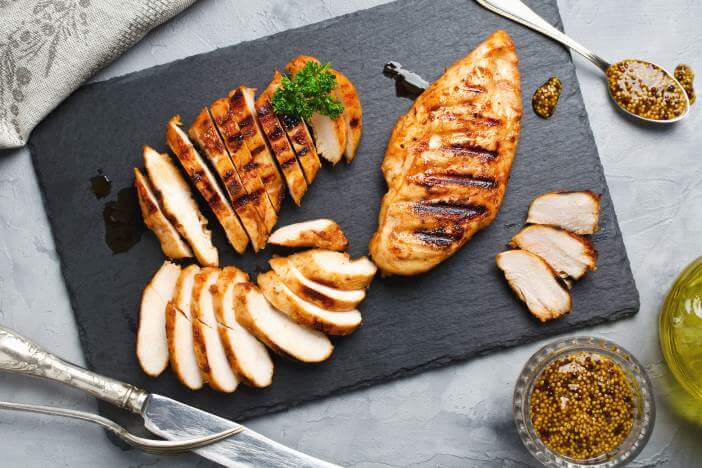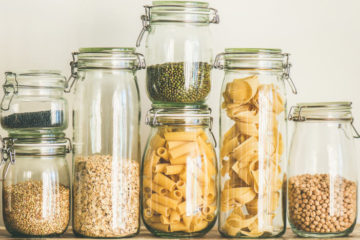Dukan Diet

Dukan Diet: What is it and how does it work?
The Dukan Diet is structured in four phases. Its length is individually adjustable. You can calculate your ideal weight online, as well as the neccessary duration of the diet needed to reach your goal. The diet plan for the Dukan Diet is very strict and the food that is allowed is precisely stated. Therefore, coaching sessions are also offered (for a fee).The Dukan Diet starts with the Attack phase (1 to 10 days), in which only foods that are high in protein and low in fat are allowed. You may eat as much and as often as you want from a list of around 70 foods. To support digestion in this low fibre phase, one tablespoon of oat bran a day is included. Every day, there is a 20 minute walk. This is followed by the Cruise phase of the Dukan Diet, which continues until the desired weight has been reached. Every other day follows the rules of the first phase, but in between, some vegetables may be eaten. The permitted vegetables are stated in the plan. In this phase, three tablespoons of oat bran are consumed a day and the walks are extended by another ten minutes. Next comes the Consolidation phase. This lasts 10 days per kilo lost and aims to keep the weight off and rule out a yo-yo effect. All foods from the first phase are allowed as well as vegetables, one portion of fruit a day and two slices of wholemeal bread. In addition, for two meals a week, you can eat whatever you want. One strict protein day per week from phase one remains in place. The Dukan Diet concludes with the Stabilisation phase, which has only three rules: a balanced diet, one protein day a week and daily walks. This is to ensure permanent weight loss.
What is allowed in the Dukan Diet and what is not allowed?
| Allowed | Reduced / in small quantities |
|---|---|
| Meat | Carbohydrates like pasta, rice, potatoes and bread |
| Fish | Sugar |
| Eggs and other animal products | Fat |
| At the beginning: high-protein and low-fat foods | Alcohol |
| Later on also fruit and wholemeal products |
Who is the Dukan Diet suitable for?
- This type of diet in its normal form can be carried out by any healthy person who is prepared to severely restrict their diet.
- Of course it is more difficult for some people to give up carbohydrates than for others.
- Extreme forms of low carb diets are difficult to sustain and are not advisable for everyone. You may achieve faster results, but unfortunately, they do not always last.
Advantages and disadvantages of the Dukan Diet
| Advantages | Disadvantages |
|---|---|
| You can eat as much of the specified food as you like. | Very limited choice of food. |
| The almost complete omission of carbohydrates triggers fast weight reduction. | Requires a large amount of discipline. |
| Withdrawal symptoms are possible due to the omission of carbohydrates. |
Dukan Diet in Detail
How individual is the Dukan Diet?
- The choice of permitted food is very small and does not offer much scope for individual adjustments regarding taste preferences.
- The Dukan Diet is not compatible with special diets like vegetarianism or veganism because it includes a lot of meat and animal products.
- There are no specifications regarding quantities, which are adapted to the individual needs and goals of the dieter.
How flexible is the Dukan Diet?
- The choices are limited but you can eat until you’re full. It is therefore quite flexible as there is no tedious calorie counting.
- Going out for dinner or to barbeques is no problem either, since meat is almost always on the menu. You should however avoid carbohydrate-rich side dishes like potatoes, rice or pasta.
How suitable is the Dukan Diet for everyday?
- The Dukan Diet begins with completely eliminating foods that are very high in carbohydrates, for example pasta, potatoes and rice. Therefore it requires a large or complex change in cooking/eating habits.
- The choice or variety of recipes is limited and the lack of carbohydrates can lead to serious side effects, such as fatigue, lack of energy, headaches, etc.
How scientific is the Dukan Diet?
- The nutritional principle behind the Dukan Diet is as follows: in the low-fat diet without carbohydrates, the focus is mainly on proteins. According to Dukan, these have the advantage of being harder to digest than other nutrients. Therefore more energy is required to break them down in the digestive tract and the feeling of satiety lasts longer.
- In the long term, however, such a protein-rich diet can also lead to kidney damage. Also, the drastic reduction in carbohydrates can lead to a lack of energy, fatigue, headaches and a lack of concentration.
- The increased intake of fluids is also particularly important. The type of drink does not matter (water, tea or even soft drinks). Protein processing produces a lot of uric acid, which is later excreted via the kidneys. If the protein intake is too high, the probability of toxic substances being stored in the body increases. This is how kidney damage occurs.
- From a scientific point of view, the Dukan Diet is not particularly well suited for losing weight over a long period of time.
How sustainable is the Dukan Diet and what risks does it hold?
- Correctly performed, weight loss through the Dukan Diet is very likely.
- If the deficit is simply too high, there is an increased risk of gaining weight again once the diet is ended.
- The Dukan Diet is designed so that towards the end, more and more carbohydrates are integrated into the diet. This is so that the body slowly gets used to the change and the diet can be continued in its more lenient form, if the motivation is there to do so.
- The Dukan Diet is extremely high in protein. Too much protein puts considerable long-term strain on the kidneys.
- A vitamin and nutrient deficiency can be expected due to the low intake of fruit and vegetables. Reduced fat dairy products also often contain additives that should not be consumed in large quantities.
Conclusion and Rating
In conclusion, the Dukan Diet is suitable for losing weight. It is however very damaging to health and difficult to sustain for a long period of time due to the drastic lack of carbohydrates. It achieves fast results and does not leave you feeling hungry, as you can eat as much of the permitted food as you would like. Since the diet cannot/should not be carried out over a long period of time and because of the nutritional deficiencies, the danger of experiencing the yo-yo effect on ending the diet is very high.
| Criteria | Rating |
|---|---|
| Potential to individualise | ◆◆◈◇◇ |
| Flexibility | ◆◆◆◇◇ |
| Difficulty & Suitability for everyday | ◆◆◆◈◇ |
| Scientific Background | ◆◆◈◇◇ |
| Sustainability | ◆◆◇◇◈ |
| Overall Rating | ◆◆◆◇◇ |
Dukan Diet vs. Upfit
| Criteria | Dukan Diet | Upfit |
|---|---|---|
| Potential to individualise | ◆◆◇◇◇ | ◆◆◆◆◆ |
| The choice of permitted food is very small and does not offer much scope for individual adjustments regarding taste preferences. The Dukan Diet is not compatible with special dietery habits like vegetarianism or veganism because it contains a lot of meat and animal products. | Adapted to your goal, taking into account allergies, intolerances and eating habits. Optional adaptation to your personal diet is available, such as vegetarian, vegan, pescetarian, flexitarian or paleo. Features like "Meal-Switcher" and "Favourite Dishes" individualise the plan. | |
| Flexibility | ◆◆◆◇◇ | ◆◆◆◆◇ |
| The choices are limited but you can eat until you're full. It is therefore quite flexible as there is no tedious calorie counting. | Meals are pre-planned. The Meal-Switcher and pre-determined details allow the diet to be adapted to the individuals everyday life. Meals can be skipped when visiting a restaurant. | |
| Suitability for everyday | ◆◆◆◇◇ | ◆◆◆◆◈ |
| The Dukan Diet begins with completely eliminating foods that are very high in carbohydrates, for example pasta, potatoes and rice. Therefore it requires a large or complex change in cooking/eating habits. | Suitable for everyday use, thanks to the cooking times and the fact that it takes your food budget into account. For those who are extremely busy and have to fit mealtimes around their jobs, midday cooking can be excluded and/or the time saving pre-cooking option can be used. | |
| Scientific background | ◆◆◈◇◇ | ◆◆◆◆◆ |
| The nutritional principle behind the Dukan Diet is as follows: in the low-fat diet without carbohydrates, the focus is mainly on proteins. According to Dukan, these have the advantage of being harder to digest than other nutrients. Therefore more energy is required to break them down in the digestive tract and the feeling of satiety lasts longer. From a scientific point of view, the Dukan Diet is not particularly well suited for losing weight over a long period of time. | Dishes and snacks are scientifically sound and are compiled according to your personal requirements for nutrients and vitamins. Portion sizes are set according to your goal and are based on a low-carbohydrate nutritional principle, developed in cooperation with sports scientists and nutritionists. | |
| Sustainability | ◆◆◇◇◇ | ◆◆◆◆◆ |
| Correctly performed, weight loss through the Dukan Diet is very likely.If the deficit is simply too high, there is an increased risk of gaining weight again once the diet is ended. | Dishes and snacks are scientifically sound and are compiled according to your personal requirements for nutrients and vitamins. Also, portion sizes are set according to your goal. These factors result in a healthy and long-term weight loss. The diet can also be carried out over an indefinite period of time. | |
| Total | Dukan Diet | Upfit |
| ◆◆◆◇◇ | ◆◆◆◆◆ |



